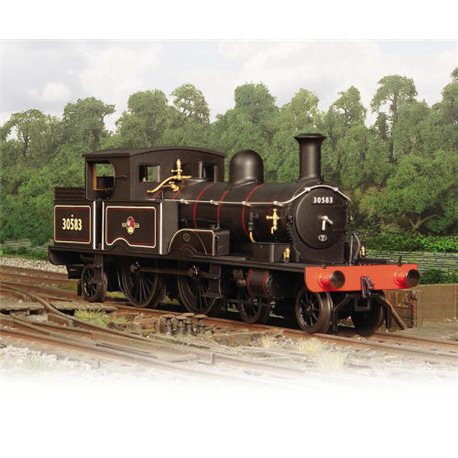No products
Product successfully added to your shopping cart
There are 0 items in your cart. There is 1 item in your cart.
Christmas and New Year
We are dispatching orders every weekday apart from Christmas Day, Boxing Day and New Year's Day.
If you order is time critical, select next day delivery at checkout.
The shop in Sandown is closed from 25th December, reopening on 30th December.
 View larger
View larger Class 415 Adams Radial BR Late 30583 Steam
76AR001
Oxford
Class 415 Adams Radial BR Late 30583 Steam
- 5 Pole skew wound motor
- 8 Pin DCC Ready
- Geared for slow prototypical operation
- Sprung Buffers
- Detailed Cab Interior
- Weighted Chassis for extra pulling power
- All over spray with precision printing
- NEM Couplings
- Pickups on all the wheels
OO gauge (1/76).
This product is out of stock
| Scale | OO (1/76) |
More info
Class 415 Adams Radial BR Late 30583 Steam
- 5 Pole skew wound motor
- 8 Pin DCC Ready
- Geared for slow prototypical operation
- Sprung Buffers
- Detailed Cab Interior
- Weighted Chassis for extra pulling power
- All over spray with precision printing
- NEM Couplings
- Pickups on all the wheels
The Class 415 later to be reclassified as 0415, Adams Radial was designed by William Adams and introduced in 1882 for operation on the London and South Western Railway (LSWR) with the design being inspired by the early LSWR Class 46. The Class 415 was based on a 4-4-0 wheel configuration but with a trailing bogie which was so fitted to support an enlarged coal bunker that was required for the highly intensive suburban services suitable for the LSWR network. The term ‘Radial’ refers to the location and positioning of the trailing bogie and how it is located onto the chassis, which in the case of the ‘415’ is in the middle.
The production of the ‘415’ locomotives commenced in 1882 with orders placed with four locomotive works, which by the end of production in 1885 numbered 71. The companies used were Robert Stephenson & Co. who built 28, Dübs & Co. were responsible for 20, Neilson & Co. produced 11 and Beyer, Peacock and Company constructed 12. Under normal circumstances these 71 locomotives would have been built at the LSWR’s own works at Nine Elms, however at the time of requirement the Nine Elms locomotive works were working at full capacity and therefore could not accept the order.
Even though all of the 71 were constructed to the same basic design, those locomotives that were built from 1884 onwards had slightly larger side water tanks and deeper fireboxes, the combination of which helped to increase the locomotive’s efficiency. All of the Class were built featuring the Adams stove pipe chimney but when Dugald Drummond became Superintendent of the LSWR the Class 415 locomotives were slightly modified with the addition of a lipped chimney. At the same time coal rails were added to the bunker so as to try and increase the locomotive’s capacity. None of the locomotives were ever equipped with superheaters.
In service the locomotives found favour with the crews that drove them, however their time as the locomotive of choice for the London suburban services was limited when first the Adams T1 0-4-4 started to replace them from such services. Eventually the introduction of Drummond’s M7 linked to the electrification of the routes finally terminated the operation of the ‘415s’ on the London LSWR rails and removing the ‘Radials’ to rural duties in 1885. However, in 1903 there was a use found for them on the severely curved Lyme Regis branch where such locomotives as the Stroudley Terriers and Adams 02 had proved unsuccessful. Eventually three of the 415 Class had their trailing axles modified and consequently they were found to be most suitable for the demands of that line. Two of the Class were allocated to Exmouth Junction for the Axminster to Lyme Regis route while a third locomotive joined them as late as 1946 having been obtained from the East Kent Railway.
The First World War probably saved the bulk of the class from being scrapped, although by 1921 thirty eight of the Class had been withdrawn. Several of the Adams Radials were used on the Highland Railway while the locomotive that eventually found itself in 1946 working with the remaining two of the Class was in 1917 sold to the Ministry of Munitions and then later worked on Ridham Docks close to Sittingbourne. The same locomotive, which was numbered 0488 was eventually purchased by Colonel Stephens for use on the East Kent Railway in 1923 but having remained there and being used sporadically the locomotive was eventually sold and joined the other two remaining Class 0415 locomotives.
With the Grouping of 1923 and the formation of the Southern Railway, only thirty Adams Radials had survived and as already mentioned eventually only three of the Class remained untouched by the Cutter’s Torch. These three surviving Adams Radials continued to work on the Lyme Regis branch after Nationalisation as there were no other suitable locomotives available. By 1958 all three of the Class were beginning to show their age and in 1961 all had been withdrawn. After withdrawal numbers 30582, formerly 125 and 30584, formerly 520 were scrapped while locomotive 30583, formerly 488 was obtained by the Bluebell Railway where it can be currently viewed in LSWR livery.

